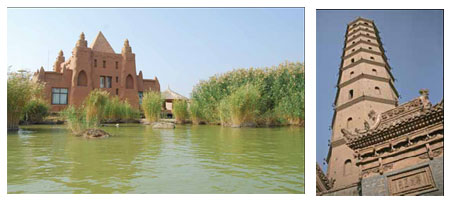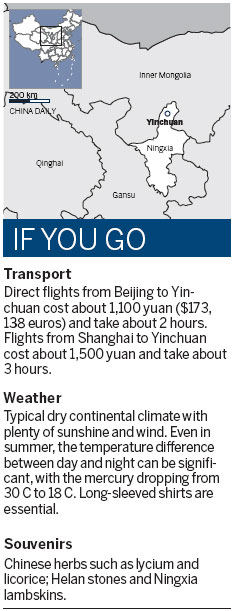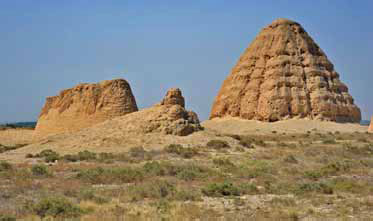Silver escapades
Updated: 2012-08-31 10:44
(China Daily)
|
||||||||

|
Clockwise from top left: Shahu Lake is surrounded by lush marshlands and desert. West Pagoda is an 11-story octagonal brick building. The cone shaped Xixia relics seem like the Chinese version of the pyramids of Egypt. Photos Provided to China Daily |

Northwestern oasis offers surreal mix of history and scenery
Amid arid expanses of loess and desert, to the east of Helan Mountain and west of the Yellow River, lies the city of Yinchuan. With a name that literally means "silver river", the capital of the Ningxia Hui autonomous region is an oasis protected by the river and mountain range to enjoy a vibrant culture supported in part by ample agriculture.
Rice cultivation in Yinchuan has labeled it "a land of fish and rice at the frontier". Founded in 678, the city boasts a Dangxiang ethnic group that settled there in 1038, creating the Western Xia Dynasty (1038-1277)that in turn left a unique and colorful heritage and architecture.
As one of the economic and cultural hubs of Northwest China, Yinchuan is currently home to more than 25 ethnic groups including the Hui, Mongolian and Manchu, which together account for more than 28 percent of its population. The Hui ethnic group is the most populous ethnic group, making up close to 27 percent of its residents.
The best time to visit Yinchuan is from May to October. High temperatures in the daytime in summer will usually cool by evening and make way for tender breeze and comfortable stays.
Here are some of the best places to go:
1. West Pagoda
Located at No 121 Limin Street, this pagoda, which is also known as the Chengtian Temple Pagoda, is an 11-story octagonal brick building built in the 11th century and later rebuilt by the 16th son of Zhu Yuanzhang, the first emperor of the Ming Dynasty (1368-1644). With a height of about 65 meters, it is a landmark of Yinchuan's old town and one of the eight ancient structures of Ningxia.
Locals say that some of the remains of the Buddha Sakyamuni are buried beneath the pagoda's base.
The temple grounds also serve as a provincial museum with an extensive collection of antiques, in particular artifacts unearthed from the Western Xia Dynasty.
A comprehensive exhibition of the Hui people is also on display. Members of the ethnic group were originally descendants of Arab and Persian traders along the Silk Road. They later settled in the Chinese frontiers and mingled with the local Han people.
2. Xixia Wangling National Park (Western Xia Imperial Tombs)
This park is home to nine tombs of the rulers of the Western Xia Dynasty and 253 companion tombs, in which are buried members of the imperial family and Dangxiang aristocrats. It is considered one of China's best protected and tomb relic sites.
The tombs spread out within an area of 50 square km on the eastern side of the Helan Mountain and are located 30 km from downtown Yinchuan.
Unlike most other imperial tombs in China, the Xixia relics are cone shaped. From above, the mysterious-looking tombs can also seem like the Chinese version of the pyramids of Egypt.
The biggest tomb covers an area of 150,000 sq m and is called the Tai tomb. It is believed to be that of the first emperor of the Western Xia Dynasty. The tomb is an independent structure equipped with turrets, stele pavilions, archways, outer walls, an inner city, memorial hall, altar and divine wall.
After the Mongolian invasion, the Dangxiang ethnic group died out. There is no other trace of the Dangxiang aside from these remains. Few scholars can read the Western Xia calligraphy but with the discovery of the tombs, it is now possible to decipher and uncover the truth behind their extinction.
3. Shahu Lake (Sand Lake)
The lake lies 56 km from downtown Yinchuan and covers about 9 sq km. It is surrounded by lush marshlands as well as desert.
Boating here is a unique experience for travelers to enjoy a combination of contrasting landscapes of sand, water, reeds, birds, mountains and lotuses.
The reed marshes are home to more than 140 animal and bird species, among which several species of swan and white crane hover about in spring to make this one of the top venues for bird watching.
In summer, lotuses blossom and other flora such as water lilies and reed bamboos grow to form a sea of natural greenery.
Sliding down the sand dunes is a popular activity. Other sports like water motorcycling and surfing are also available. On the south bank, an international sand carving "art zone" boasts a large collection of exhibits.
Eating and drinking
Delicacies here are mostly made up of Muslim dishes, with mutton and beef taking the top spots. Mutton Eaten with Fingers is a staple and while most people no longer directly use their fingers to pick out the meat, the traditional snack can still be found in almost every alleyway of the city.
A haggis-like dish is another local specialty, made of sliced mutton, vermicelli and diced Chinese pancake soaked in hot mutton soup with chili and scallions. Flour-based snacks are also popular with fried huahua, shaped like a donut but more crispy.
China Daily

 'Taken 2' grabs movie box office crown
'Taken 2' grabs movie box office crown
 Rihanna's 'Diamonds' tops UK pop chart
Rihanna's 'Diamonds' tops UK pop chart
 Fans get look at vintage Rolling Stones
Fans get look at vintage Rolling Stones
 Celebrities attend Power of Women event
Celebrities attend Power of Women event
 Ang Lee breaks 'every rule' to make unlikely new Life of Pi film
Ang Lee breaks 'every rule' to make unlikely new Life of Pi film
 Rihanna almost thrown out of nightclub
Rihanna almost thrown out of nightclub
 'Dark Knight' wins weekend box office
'Dark Knight' wins weekend box office
 'Total Recall' stars gather in Beverly Hills
'Total Recall' stars gather in Beverly Hills
Most Viewed
Editor's Picks

|

|

|

|

|

|
Today's Top News
Health new priority for quake zone
Xi meets US top military officer
Japan's boats driven out of Diaoyu
China mulls online shopping legislation
Bird flu death toll rises to 22
Putin appoints new ambassador to China
Japanese ships blocked from Diaoyu Islands
Inspired by Guan, more Chinese pick up golf
US Weekly

|

|








